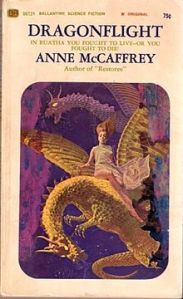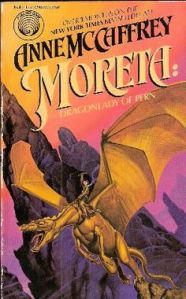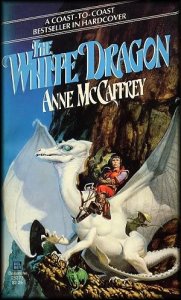When I am reading, I become invested in the characters and their problems. The authors I like best use the environment to highlight the characters’ moods and darken or lighten the atmosphere. Their worldbuilding conveys a perception of drama with minimal exposition.
 In a novel or story, each scene occurs within the framework of the environment.
In a novel or story, each scene occurs within the framework of the environment.
I think of the written narrative as a camera and visualize my narrative as a movie. The challenge of writing for me is discovering how to best use the set dressing to underscore the drama.
Scene framing is a necessary skill for writers of all stripes. Directors will tell you they focus the scenery so it frames the action. Their intent is that viewer’s attention is drawn to the subtext the director wants to convey.
An example of how this works in literature is one I’ve used before, a pivotal scene from Anne McCaffrey’s 1988 novel Dragonsdawn.
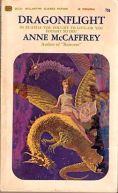 The Dragonriders of Pern series is considered science fiction because McCaffrey made clear at the outset that the star (Rukbat) and its planetary system had been colonized two millennia before, and the protagonists were their descendants.
The Dragonriders of Pern series is considered science fiction because McCaffrey made clear at the outset that the star (Rukbat) and its planetary system had been colonized two millennia before, and the protagonists were their descendants.
Some elements of the narrative are considered fantasy because they feature dragons and telepathy.
The early novels detail the gradual rediscovery of lost technology and the revelation of their forgotten history. The stand-alone novel I’m discussing today, Dragonsdawn, is a how-it-all-began novel, and it reinforces the science fiction nature of the series.
- It explains the science behind McCaffrey’s dragons and why they were genetically engineered to be what they are.
The story follows several POV characters, giving us a comprehensive view of the colony’s successes and failures. For the first ten years, the planet Pern seemed a paradise to its new colonists, who were seeking to return to a less technologically centered, agrarian-based way of life. They believe Pern is the place where they can leave their recent wars and troubles behind.
A decade after arriving on the planet, however, a new threat appears. It is a deadly, unstoppable spore that periodically rains from the skies in the form of a silvery Thread that mindlessly devours every carbon-based thing it touches.
 The scenes we are looking at today have two distinct environments to frame them. In both settings, the surroundings do the dramatic heavy lifting. This chapter is filled with emotion, high stakes, and rising dread for the sure and inevitable tragedy that we hope will be averted.
The scenes we are looking at today have two distinct environments to frame them. In both settings, the surroundings do the dramatic heavy lifting. This chapter is filled with emotion, high stakes, and rising dread for the sure and inevitable tragedy that we hope will be averted.
- While there is high drama in Sallah Telgar‘s direct interaction with Avril Bitra, the visuals and sensory elements of each environment reinforce the perception of impending doom.
The story at this point: We are at the halfway point of the book. Before the advent of Thread, Avril disappeared, gathering resources and intending to leave the planet with as much treasure as she can carry. She has been pretty much forgotten by the others but has an agenda and refuses to be thwarted.
In the first scene of this chapter, we are focused on Sallah, one of our protagonists. We see her leaving her children at the daycare. Such a common, ordinary thing, dropping off your children on your way to work.
The focus zooms out, and we see Kenjo, the pilot, putting the last of the precious fuel into the only working shuttle, the Mariposa. This shuttle has been refitted for one last science expedition: to discover the source of the deadly Threads. He is to retrieve a sample, knowing that if this mission fails, there will be no other.
The focus returns to Sallah, who observes a woman she recognizes as Avril Bitra slipping through the abandoned shuttles on the landing grid.
Sallah wonders what Avril is up to. The view widens again as we see Avril following the pilot, Kenjo, who vanishes. We then see her entering the Mariposa alone.
Sallah makes a spur-of-the-moment decision to follow Avril to see what she’s up to. This plot point is an example of a point of no return, which we discussed last week,
Here is where the sparse visual mentions of the environment become crucial as they emphasize the stark reality of Sallah’s situation.
 Sallah enters the shuttle just as the airlock door closes, catching and crushing her heel. She manages to pull it out so that she isn’t trapped, but she is severely injured.
Sallah enters the shuttle just as the airlock door closes, catching and crushing her heel. She manages to pull it out so that she isn’t trapped, but she is severely injured.
Later, the dark, abandoned interior of the Yokohama reinforces Sallah’s gut-wrenching realization that her five children will grow up without a mother.
Something we haven’t talked about is subtext.
Subtext is what lies below the surface. It is the hidden story, the hints and allegations, the secret reasoning we infer from the narrative. It’s conveyed by the images we place in the environment and how the setting influences our perception of the mood and atmosphere.
Subtext supports the dialogue and gives purpose to the personal events.
Scene framing is the way we stage the people and visual objects. What furnishings, sounds, and odors are the visual necessities for that scene?
Whatever you mention of the environment focuses the reader’s attention when the characters enter the frame.
- In this chapter of Dragonsdawn, we see the junk and scrap on the grid and the decaying shuttles.
- Two shuttles have been dismantled and parted out. Their components are crucial in keeping the few cargo sleds that have been converted to Thread-fighting gunships in working order.
- Only one shuttle remains in usable condition.
- On the Yokohama, it is dark and frigid, and the interior has been partially gutted. Anything that could be carried away has been taken to the ground and repurposed.
Sensory details are vital, showing how the environment affects or is affected by the characters.
- Conversely, not mentioning the scenery during a conversation brings the camera in for a close-up, focusing solely on the speaker or thinker.
A balance must be struck in how your characters are framed in each scene. We flow from wide-angle, seeing Salla floating in freefall, blood pooling in her boot. The camera moves in, a close-up showing Avril’s rage at the fact that she can’t control the course of the Mariposa, which is programmed to dock at the Yokohama.
We are there when Avril taunts Sallah for her matronly body. A feeling of helplessness comes over us as Avril ties a cord to Sallah’s crushed foot and forces her to make the navigational calculations for Avril’s escape. The camera moves in, and we hear the interaction.
Sallah pretends to do as Avril asks. But really, she sets her enemy’s doom in action. The camera moves to the wider view again, seeing her at the controls in the dark, using the last of her energy. Worst of all, we know she is dying, and she understands there is no rescue for her.
- We hear the interaction with her frantic husband on the ground.
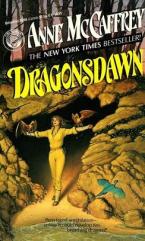 This is an incredibly emotional scene: we are caught up in her determination to seize this only chance, using her last breaths to get the information about the thread spores to the scientists on the ground.
This is an incredibly emotional scene: we are caught up in her determination to seize this only chance, using her last breaths to get the information about the thread spores to the scientists on the ground.
We learn how to write from reading the masters. We learn by observing how others use the setting to support and reinforce the subtext of the conversations and events.
Scene framing is a cornerstone of worldbuilding, and when it is done right, it can make a scene feel powerful.
Next up: Transitions


